View in other NatureServe Network Field Guides
NatureServe
Montana
Utah
Wyoming
Idaho
Wisconsin
British Columbia
South Carolina
Yukon
California
New York
Least Salmonfly - Pteronarcella badia
General Description
This species is the smaller cousin to the Giant Salmonfly, and is still a fairly large stonefly species, up to 2 inches long. In late-May to early July, adults are hatching after spending 2 years as nymphs on the bottom of the stream. The Least Salmonfly range in Montana occurs in most western drainages and in the mountain and foothill Missouri and Yellowstone Drainages downstream until the water temperatures become to warm. They can tolerate warmer water temperatures than other species in the Pteronarcys genus and overlap with the giant salmonflies in the upper reaches of the larger rivers like the Yellowstone, Clark Fork, Smith and Missouri.
Phenology
In late-May to early July, adults are hatching after spending 2 years as nymphs on the bottom of the stream.
Diagnostic Characteristics
The diagnostic characters to seperate this large stonefly species from the others in the Pteronarcyidae family are smaller size and lack of orange coloration in adults and the 2 sets of gills on the underside of the abdomen in the nymphs, whereas the Pteronarcys nymphs have 3 sets of gills on the first abdomonal segments.
Species Range
Montana Range
Range Descriptions
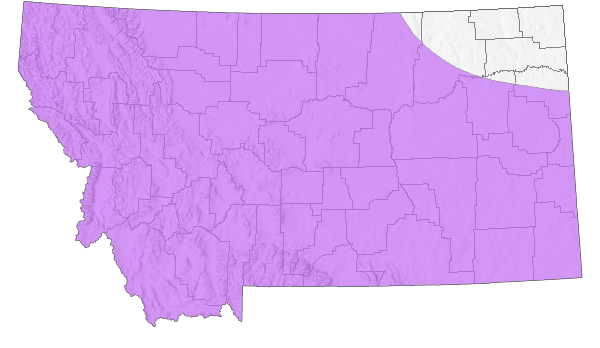
 Native
Native
Observations in Montana Natural Heritage Program Database
Number of Observations: 95
(Click on the following maps and charts to see full sized version)
Map Help and Descriptions
Relative Density
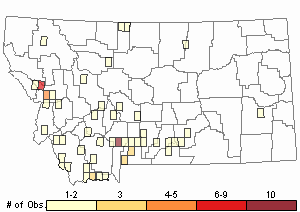
Recency
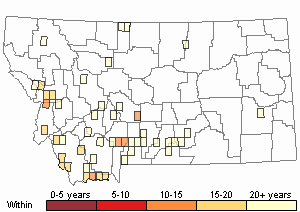
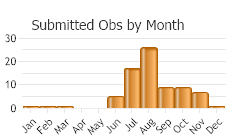

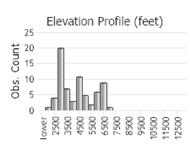 (Observations spanning multiple months or years are excluded from time charts)
(Observations spanning multiple months or years are excluded from time charts)
Habitat
Pteronarcella nymphs are found in fast flowing streams and rivers below 8000 ft (Baumann et al. 1977). They prefer large cobbles and boulders as substrate, as well as logjams where leaf materials can accumulate.
Food Habits
Pteronarcella nymphs generally are considered shredders as a functional feeding group, and feed on large particular organic and leaf materials that have collected in debris dams or behind boulders or logjams.
Ecology
Pteronarcella nymphs grow through many instars (8 - 14) during their 2 year life cycle depending on degree days (water temperature + air). They are found in fast flowing streams below 8000 ft (Baumann et al. 1977). Mature nymphs migrate to shore in the spring and climb out of the water (mostly at night) before the final molt. Adults live for a few days to few weeks among shoreline vegetation or rocks and they feed little, if at all. Males attract mates by drumming rocks or wood. After mating, females lay the eggs on or above the water. The eggs separate and sink to the bottom to begin the next generation. Multiple cohorts may exist in any given river allowing a salmonfly hatch to occur every year, but some cohorts are stronger than others.
Stewardship Responsibility
References
- Literature Cited AboveLegend:
 View Online Publication
View Online Publication Baumann, R.W, A.R. Gaufin, and R.F. Surdick. 1977. The stoneflies (Plecoptera) of the Rocky Mountains. American Entomological Society, Philadelphia.
Baumann, R.W, A.R. Gaufin, and R.F. Surdick. 1977. The stoneflies (Plecoptera) of the Rocky Mountains. American Entomological Society, Philadelphia.
- Additional ReferencesLegend:
 View Online Publication
View Online Publication
Do you know of a citation we're missing? Burns, D.C. 1973. Plecoptera of the West Fork of the West Gallatin River and factors influencing their distribution. M.Sc. Thesis. Bozeman, Montana: Montana State University. 71 p.
Burns, D.C. 1973. Plecoptera of the West Fork of the West Gallatin River and factors influencing their distribution. M.Sc. Thesis. Bozeman, Montana: Montana State University. 71 p. Driear, R. E. 1974. A comparative study of the aquatic insect populations of Rock Creek, Montana and its major tributaries. M.S. thesis. University of Montana.
Driear, R. E. 1974. A comparative study of the aquatic insect populations of Rock Creek, Montana and its major tributaries. M.S. thesis. University of Montana. Fraley, J.J. 1978. Effects of elevated summer water temperatures below Ennis Reservoir on the microinvertebrates of the Madison River, Montana. M.Sc. Thesis. Bozeman, MT: Montana State University. 120 p.
Fraley, J.J. 1978. Effects of elevated summer water temperatures below Ennis Reservoir on the microinvertebrates of the Madison River, Montana. M.Sc. Thesis. Bozeman, MT: Montana State University. 120 p. Gangemi, John Thomas. 1991. Comparative effects of wildfire and timber harvest on periphyton and zoobenthos in two northern Rocky Mountain streams. M.S. Thesis. University of Montana. Missoula, MT.
Gangemi, John Thomas. 1991. Comparative effects of wildfire and timber harvest on periphyton and zoobenthos in two northern Rocky Mountain streams. M.S. Thesis. University of Montana. Missoula, MT. Garrett, P.A. 1973. The distribution and abundance of aquatic insects in the Middle West Gallatin drainage. M.Sc. Thesis. Bozeman, Montana: Montana State University. 60 p.
Garrett, P.A. 1973. The distribution and abundance of aquatic insects in the Middle West Gallatin drainage. M.Sc. Thesis. Bozeman, Montana: Montana State University. 60 p. Gustafson, D. L. 1990. Ecology of aquatic insects in the Gallatin River drainage. Ph.D. Dissertation. Bozeman, MT: Montana State University. 194 p.
Gustafson, D. L. 1990. Ecology of aquatic insects in the Gallatin River drainage. Ph.D. Dissertation. Bozeman, MT: Montana State University. 194 p. Lehmkuhl, Dennis M. 1966. A study of the littoral invertebrates of three mountain lakes in Glacier National Park, Montana. M.A. Thesis. University of Montana. Missoula, MT.
Lehmkuhl, Dennis M. 1966. A study of the littoral invertebrates of three mountain lakes in Glacier National Park, Montana. M.A. Thesis. University of Montana. Missoula, MT. Mcclay, W. 1968. Effects of controlled flow reductions on aquatic insects in a stream riffle. M.Sc. Thesis. Bozeman, MT: Montana State University. 29 p.
Mcclay, W. 1968. Effects of controlled flow reductions on aquatic insects in a stream riffle. M.Sc. Thesis. Bozeman, MT: Montana State University. 29 p. Oswald, R.A. 1979. Observations of distribution, abundance and production-related aspects of aquatic macroinvertebrates in natural thermal gradients. M.Sc. Thesis. Bozeman, Montana: Montana State University. 137 p.
Oswald, R.A. 1979. Observations of distribution, abundance and production-related aspects of aquatic macroinvertebrates in natural thermal gradients. M.Sc. Thesis. Bozeman, Montana: Montana State University. 137 p. Sproul, J.S., D.D. Houston, C.R. Nelson, R.P. Evans, K.A. Crandall, and D.K. Shiozawa. 2015. Climate oscillations, glacial refugia, and dispersal ability: factors influencing the genetic structure of the Least Salmonfly, Pteronarcella badia (Plecoptera), in western North America. BMC Evolutionary Biology. 15:279.
Sproul, J.S., D.D. Houston, C.R. Nelson, R.P. Evans, K.A. Crandall, and D.K. Shiozawa. 2015. Climate oscillations, glacial refugia, and dispersal ability: factors influencing the genetic structure of the Least Salmonfly, Pteronarcella badia (Plecoptera), in western North America. BMC Evolutionary Biology. 15:279. Stadnyk, L. 1971. Factors affecting the distribution of Stoneflies in the Yellowstone River, Montana. M.Sc. Thesis. Bozeman, Montana: Montana State University. 36 p.
Stadnyk, L. 1971. Factors affecting the distribution of Stoneflies in the Yellowstone River, Montana. M.Sc. Thesis. Bozeman, Montana: Montana State University. 36 p.
- Web Search Engines for Articles on "Least Salmonfly"
- Additional Sources of Information Related to "Insects"





